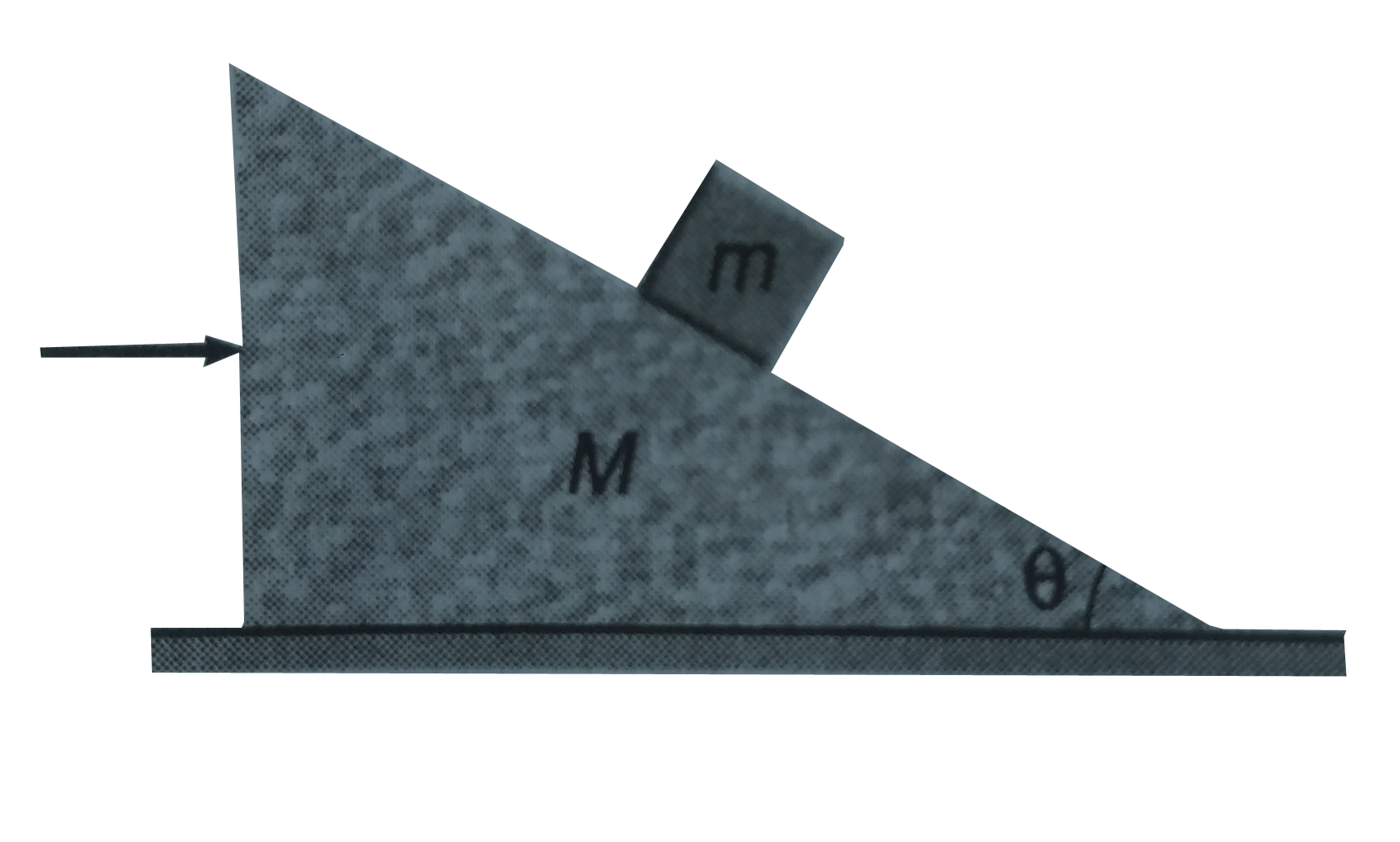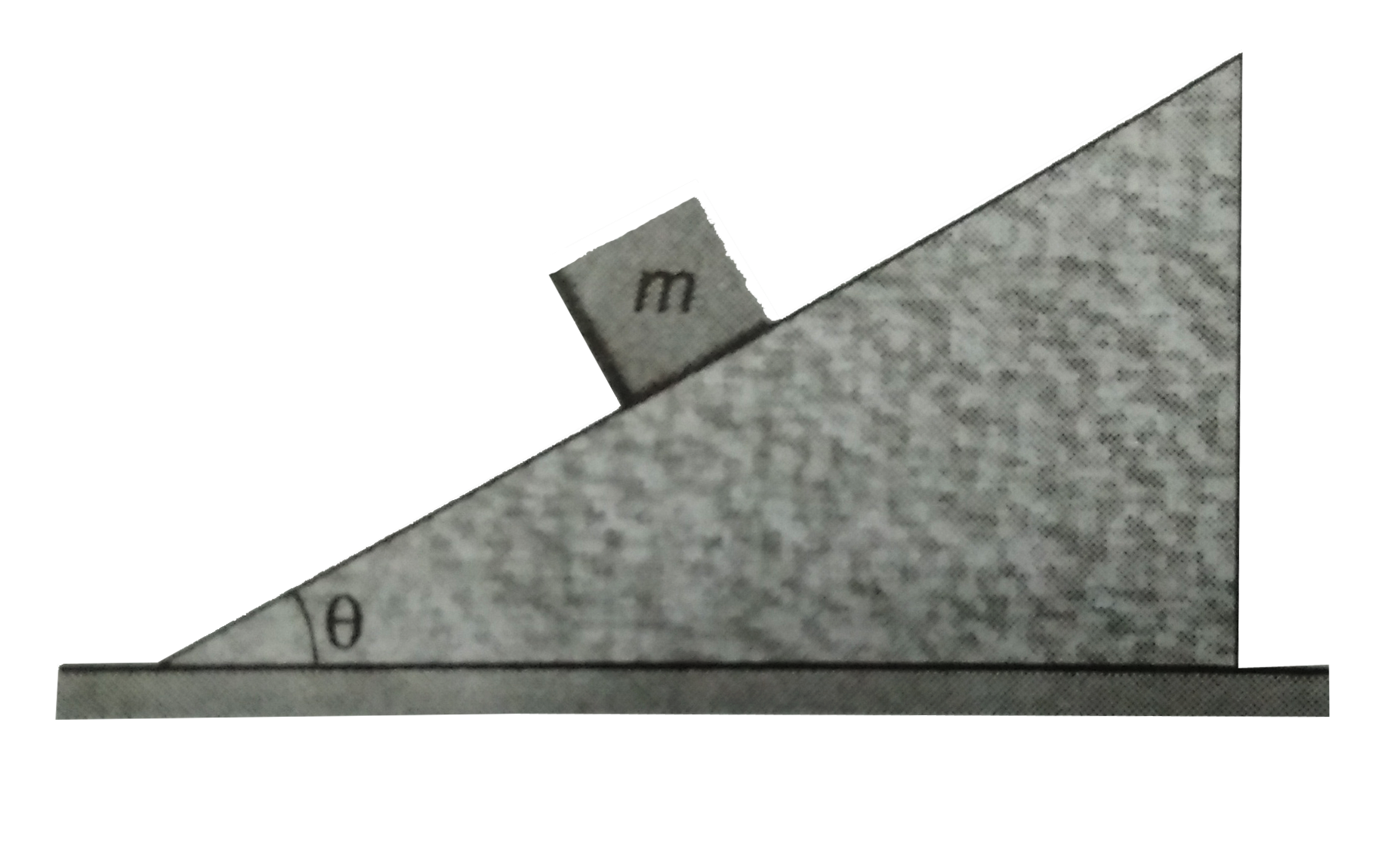A block of mass m is placed on a smooth wedge of inclination Q. The whole system is accelerated horizontally so that the block does not slip on the wedge. Find the
i) Acceleration of the wedge
ii) Force to be applied on the wedge
iii) Force exerted by the wedge on the block.
To solve the problem of a block of mass m placed on a smooth wedge of inclination θ that is accelerated horizontally, we will follow these steps:
Step 1: Analyze the Forces Acting on the Block
The block experiences the following forces:
1. Weight acting downwards: mg
2. Normal force N exerted by the wedge on the block, acting perpendicular to the surface of the wedge.
3. Pseudo force Fp=ma acting horizontally in the opposite direction of the acceleration of the wedge.
Step 2: Resolve Forces into Components
We can resolve the weight mg and the pseudo force ma into components along the axes parallel and perpendicular to the inclined plane:
- The component of the weight acting parallel to the incline: mgsinθ
- The component of the weight acting perpendicular to the incline: mgcosθ
- The component of the pseudo force acting parallel to the incline: macosθ
- The component of the pseudo force acting perpendicular to the incline: masinθ
Step 3: Set Up the Equations of Motion
Since the block does not slip on the wedge, the net force along the incline must be zero. Therefore, we can write:
macosθ=mgsinθ
Step 4: Solve for the Acceleration of the Wedge
Rearranging the equation gives us:
a=gsinθcosθ=gtanθ
Thus, the acceleration of the wedge is:
Acceleration of the wedge, a=gtanθ
Step 5: Calculate the Normal Force Exerted by the Wedge on the Block
For the vertical forces acting on the block, we have:
N=mgcosθ+masinθ
Substituting a=gtanθ:
N=mgcosθ+mgtanθsinθ
Since tanθ=sinθcosθ:
N=mgcosθ+mgsin2θcosθ
Combining the terms:
N=mg(cos2θ+sin2θcosθ)
Using the identity cos2θ+sin2θ=1:
N=mgcosθ
Step 6: Calculate the Force to be Applied on the Wedge
The total horizontal force F to be applied on the wedge can be found by considering the horizontal component of the normal force:
F=Nsinθ=mgcosθsinθ=mgtanθ
Summary of Results
1. Acceleration of the wedge: a=gtanθ
2. Force to be applied on the wedge: F=mgtanθ
3. Force exerted by the wedge on the block: N=mgcosθ
The block experiences the following forces:
1. Weight acting downwards: mg
2. Normal force N exerted by the wedge on the block, acting perpendicular to the surface of the wedge.
3. Pseudo force Fp=ma acting horizontally in the opposite direction of the acceleration of the wedge.
We can resolve the weight mg and the pseudo force ma into components along the axes parallel and perpendicular to the inclined plane:
- The component of the weight acting parallel to the incline: mgsinθ
- The component of the weight acting perpendicular to the incline: mgcosθ
- The component of the pseudo force acting parallel to the incline: macosθ
- The component of the pseudo force acting perpendicular to the incline: masinθ
Since the block does not slip on the wedge, the net force along the incline must be zero. Therefore, we can write:
macosθ=mgsinθ
Rearranging the equation gives us:
a=gsinθcosθ=gtanθ
Thus, the acceleration of the wedge is:
Acceleration of the wedge, a=gtanθ
For the vertical forces acting on the block, we have:
N=mgcosθ+masinθ
Substituting a=gtanθ:
N=mgcosθ+mgtanθsinθ
Since tanθ=sinθcosθ:
N=mgcosθ+mgsin2θcosθ
Combining the terms:
N=mg(cos2θ+sin2θcosθ)
Using the identity cos2θ+sin2θ=1:
N=mgcosθ
The total horizontal force F to be applied on the wedge can be found by considering the horizontal component of the normal force:
F=Nsinθ=mgcosθsinθ=mgtanθ
1. Acceleration of the wedge: a=gtanθ
2. Force to be applied on the wedge: F=mgtanθ
3. Force exerted by the wedge on the block: N=mgcosθ
Similar Questions
A block of mass m is placed on a smooth wedge of incination θ. The whole system s acelerated horizontally so tht the block does not slip on the wedge. The force exerted by the wedge on the block has a magnitude
View SolutionA block of mass m is placed on a smooth wedge of inclination θ. The whole system is accelerated horizontally, so that the block does not slip on the wedge. The force exerted by the wedge on the block (g is acceleration due to gravity) will be
View SolutionA block of mass m is placed on a smooth wedge of inclination θ. The whole system is accelerated horizontally, so that the block does not slip on the wedge. The force exerted by the wedge on the block (g is acceleration due to gravity) will be
View SolutionA block of mass 'm' is kept on a smooth moving wedge. If the acceleration of the wedge is 'a'

View SolutionA block of mass m is placed at rest on a smooth wedge of mass M placed at rest on a smooth horizontal surface. As the system is released

View SolutionAs shown in the figure a block of mass 'm' is placed on a smooth wedge moving with constant acceleration such that block does not move with respect to the wedge. Find work done by the net force on the block in time t. (Initial speed is 0)

View SolutionThe minimum value of acceleration of wedge for which the block start sliding on the wedge, is:
View Solution
A smooth wedge of mass M is pushed with an acceleration a=>anθ and a block of mass m is projected down the slant with a velocity v relative to the wedge.
The horizontal force applied on the wedge is:
View SolutionAll surfaces are smooth in following figure. Find F, such that block remain stationary with respect to wedge.

View SolutionA block of mass m is at rest on a rought wedge as shown in figure. What is the force exerted by the wedge on the block?

View Solution
